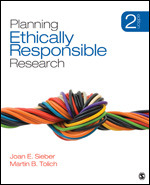Planning Ethically Responsible Research
- Joan E. Sieber - California State University, East Bay, USA
- Martin B. Tolich - University of Otago, New Zealand
"Two important aspects covered in this text are the ethical considerations in qualitative research methodologies, and the attention that is needed in University Research Ethics Committees to understanding and addressing these methodologies."
“I particularly enjoyed the energetic and experienced tone of these writers and their willingness to take a stance...The chapters in the second half of the book on consent, confidentiality and autoethnography have thoughtful coverage of qualitative research issues. Equally welcome is their attempt to come up with constructive solutions rather than to simply criticize...The authors have established record in developing an evidence base on human research ethics and I shall be bringing their final chapter, with its ‘Ten Simple Solutions for Making Ethics Review a Learning Institution’, to my own ethics committee.”
I was curious to see if there was material here that I might use to introduce the subject of ethics in research to my students. I have currently placed this on my course reading list.
This one as the one of the textbook in my research methods course
PERR 2 has the same basic objective as the First Edition of providing the theory and practical knowledge needed to plan ethically responsible research. However, it has broadened this objective in myriad ways, including the following. It:
· Explains the sensible origins of ethical requirements that have become senseless rules in some research contexts;
· Explores conflicts of interest between research and institutional objectives;
· Examines the sources of ethical research behavior beyond mere adherence to regulations;
· Bases its recommendations on evidence-based ethical problem solving;
· Introduces ethical theory and shows how theories of normative ethics relate to major national guidelines governing human research;
· Examines the special problems that arise when ethical requirements based on the medical model of human research are applied to field research and qualitative research;
· Examines the proper role of methodologies in addressing research problems and related ethical problems;
· Explores ethical and regulatory issues in greater depth in relation to specific research methods;
· Examines many of the emerging issues that were not discussed in 1992, e.g., conflict of interest, internet research, generic research, data sharing, experimental economics, and many others;
· Presents multiple viewpoints on controversial issues (i.e. Milgram's Obedience Studies, Zimbardo's Stanford Prison Experiment, Humphreys' Tearoom Trade);
· Makes extensive use of internet resources;
· Provides major guidance to IRBs and investigators so that they can indeed plan ethically responsible research instead of resorting to one-size-fits-all rules that may be highly ineffective in some contexts and cultures. It is about planning for the unexpected before, during and after the research is conducted, and understanding the inherent uncertainty that surrounds any such plans.
· Seeks to spell out the responsibilities equally for researchers, IRBs, and the various institutions including research institutions, relevant scientific and professional societies, and seek to promote the establishment of a more collegial, trusting relationship among these various stakeholders.
A major theme in the book is problems that arise after review by an IRB.

 Sage College Publishing
Sage College Publishing

